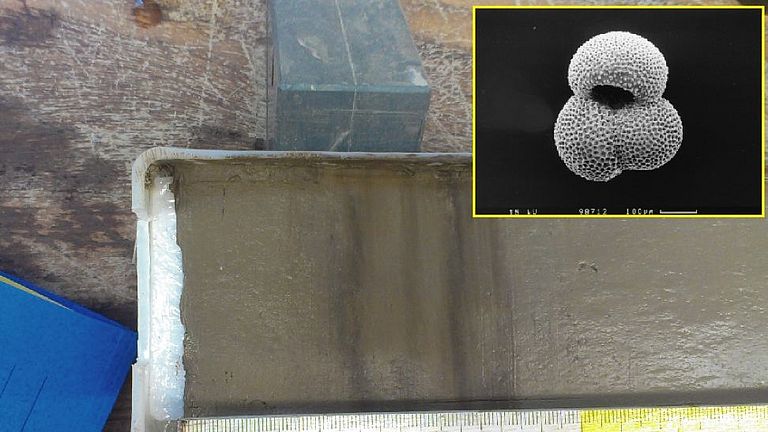How salt from the Caribbean affects our climate
Study explores link between salinity, ocean currents and climate
Joint press release by MARUM - Center for Marine Environmental Sciences at the University of Bremen and GEOMAR Helmholtz Centre for Ocean Research Kiel
The distribution of salt by ocean currents plays a crucial role in regulating the global climate. This is what researchers from Dalhousie University in Canada, GEOMAR Helmholtz Centre for Ocean Research Kiel, Alfred Wegener Institute, Helmholtz Centre for Polar and Marine Research (AWI) and MARUM – Center for Marine Environmental Sciences at the University of Bremen have found in a new study. They studied natural climate anomalies, including the so-called Little Ice Age. This cold period from the 15th to the mid-19th century led to poor harvests, famine and disease in Europe. Although the Little Ice Age is one of the most studied periods in recent history, the underlying climatic mechanisms remain controversial.
“Looking at recent, natural climate anomalies helps to understand the processes and mechanisms that human-induced global warming may trigger,” says Dr Anastasia Zhuravleva, lead author of the study. She was a PhD student at GEOMAR and received the Annette Barthelt Prize for her dissertation in 2019. She then worked as a post-doctoral researcher at GEOMAR and Dalhousie University, where the study was completed.
“Researchers often consider an increase in sea ice extent and desalination in the subpolar North Atlantic as possible triggers for past cold periods, but processes in the tropical Atlantic appear to be equally important," says Dr Zhuravleva. “In fact, in contrast to the northern and mid-latitudes, there is little information on these recent climate events from the subtropical-tropical Atlantic and their impact on regions in the Northern Hemisphere,” adds Dr Henning Bauch, paleoclimatologist at AWI and GEOMAR, co-initiator and co-author of the study. “This is where our research comes in.”
So, what happened in the tropical Atlantic during historical climate anomalies, and how might potential changes there have affected ocean circulation and climate much further north? To answer these questions, the team worked on a sediment profile from the southern Caribbean and reconstructed the salinity and temperature of the surface water over the last 1700 years. Among other things, the researchers determined the isotopic and elemental composition of the calcareous shells of plankton.
The results show a cooling of about 1°C during the Little Ice Age. “It is a significant temperature change for this region,” says Dr Mahyar Mohtadi, co-author of the study and head of the Low Latitude Climate Variability group at MARUM. “Particularly noteworthy is the occurrence of another pronounced cooling for the 8th-9th centuries. Colder temperatures in the otherwise warm tropical ocean led to lower regional rainfall, which coincided with severe droughts in the Yucatan Peninsula and the decline of the Classic Maya culture.”
In addition, the researchers found that the cold climate anomalies in the subpolar North Atlantic and Europe were accompanied by weaker ocean circulation and increased salinity in the Caribbean. “Advection, or the movement of tropical salt to high northern latitudes, is essential for maintaining high surface densities in the subpolar North Atlantic. This is a prerequisite for the overall stability of the large-scale ocean circulation, including the transfer of warm Gulf Stream water, which is responsible for our mild temperatures in Europe,” says Dr Bauch.
The data on the historical past thus allow a reconstruction of the connection across the North Atlantic. Initial cooling can be caused by volcanic eruptions, low solar activity and feedbacks between sea ice and the ocean in the north. The new study provides evidence that a decrease in salt movement to high northern latitudes will amplify and prolong these climate events. Conversely, the slow movement of positive salinity anomalies from the tropics will eventually increase the density at the surface of the subpolar North Atlantic. This may favour the northward transport of heat by ocean currents, resulting in milder temperatures over Europe and North America.
“Such a salinity feedback is known from models and has been assumed for the Little Ice Age. However, in the absence of tropical ocean data, these assumptions have been based on less direct precipitation records,” says Dr Zhuravleva.
There is evidence that the Gulf Stream is weakening and that human-induced warming is a likely cause. What is certain is that the consequences of this change will be global. The extent to which the different climate mechanisms interact has been an open question. This study now confirms that the south-north transport of salt is a key factor in the processes involved.
Original publication:
Zhuravleva, A. et al (2023): Caribbean salinity anomalies contributed to variable North Atlantic circulation and climate during the Common Era: Tropical salinification and historical cold anomalies. Science Advances, doi: 10.1126/sciadv.adg2639. http://doi.org/10.1126/sciadv.adg2639

Model simulation of the surface flow speed in the Atlantic showing the Gulf Stream and the position of the investigated Caribbean sediment core. The new study reaffirms that meridional salt advection by North Atlantic currents is a crucial feedback mechanism for climate regulation. Simulation: GEOMAR

Analyzed sediment core from the Caribbean Sea. The inset shows a foraminifera species called Globigerinoides ruber (white), which was extracted from the sediment samples and used to reconstruct past changes in tropical temperature and salinity. Photo: A. Zhuravleva and T. Boeschen, GEOMAR


